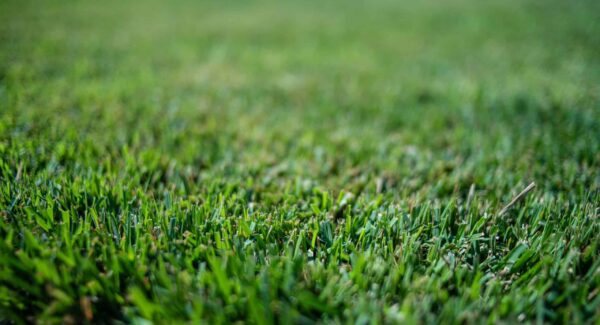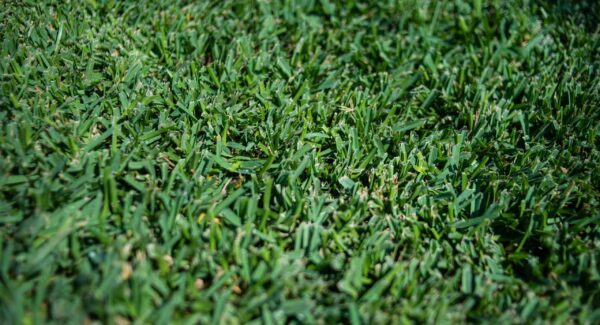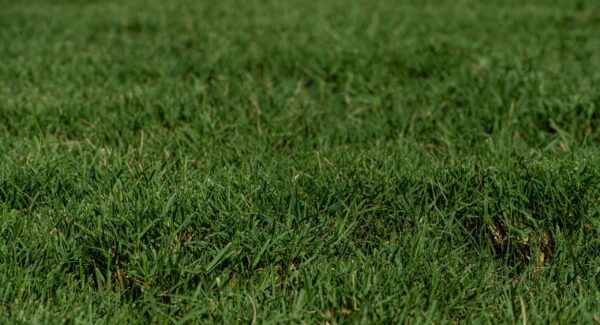How to Protect New Grass from Frost
As winter approaches, it’s essential to consider how colder temperatures might affect your lawn, especially if you’ve recently planted new grass. Frost can damage young grass by freezing water inside its delicate tissues, stopping growth and weakening the plant.
To help your lawn survive the winter and stay healthy, it’s essential to take a few simple steps to protect it from frost. This post will explain why frost can harm new grass and how to keep your lawn safe during the colder months.
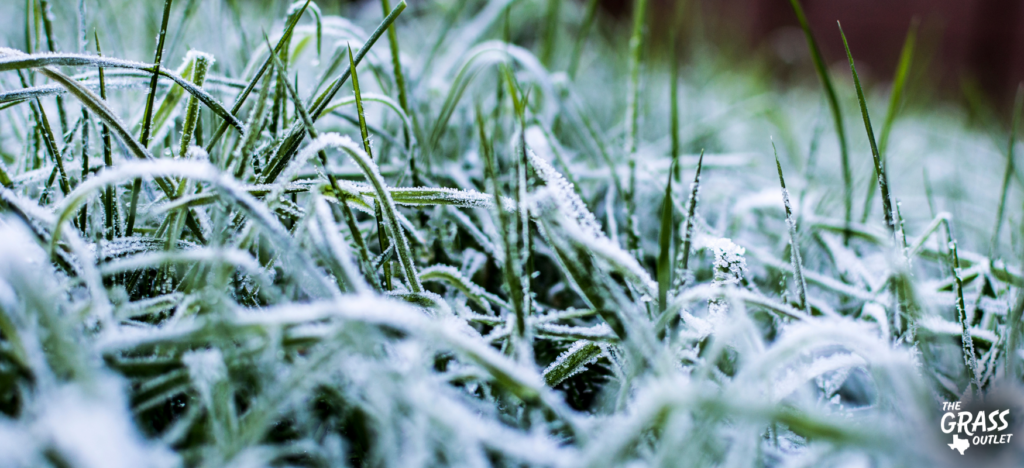
How Frost Affects New Grass
Frost forms on cold, clear nights when the temperature of the ground and plants drops below that of the air. While established lawns can recover from light frost damage, new grass is much more vulnerable. How does frost affect new grass?
Understanding this impact can help protect your lawn better during these colder months. Frost freezes the water inside grass blades, causing the cell walls to expand and break. This not only damages the blades but also makes the grass more fragile, especially if walked on. While the roots of established grass can help repair damage, new grass lacks the strength to recover as quickly, making frost a much more significant threat. After nights of light frost or a single heavy frost, the plant faces increased strain to recover. Some lawns may enter dormancy and remain inactive until the temperatures rise again.
Signs of Frost Damage on Grass
Frost damage can impact lawns in various ways, and its severity often depends on the grass species. While some types of grass are more tolerant of freezing temperatures, others show clear signs of stress and damage. For instance, Bermuda grass can quickly turn brown and patchy, potentially dying off if the cold persists. In contrast, St. Augustine grass often shows discoloration in the affected areas, ranging from brown and yellow to purple. Recognizing the symptoms of frost damage early is essential for effective intervention.
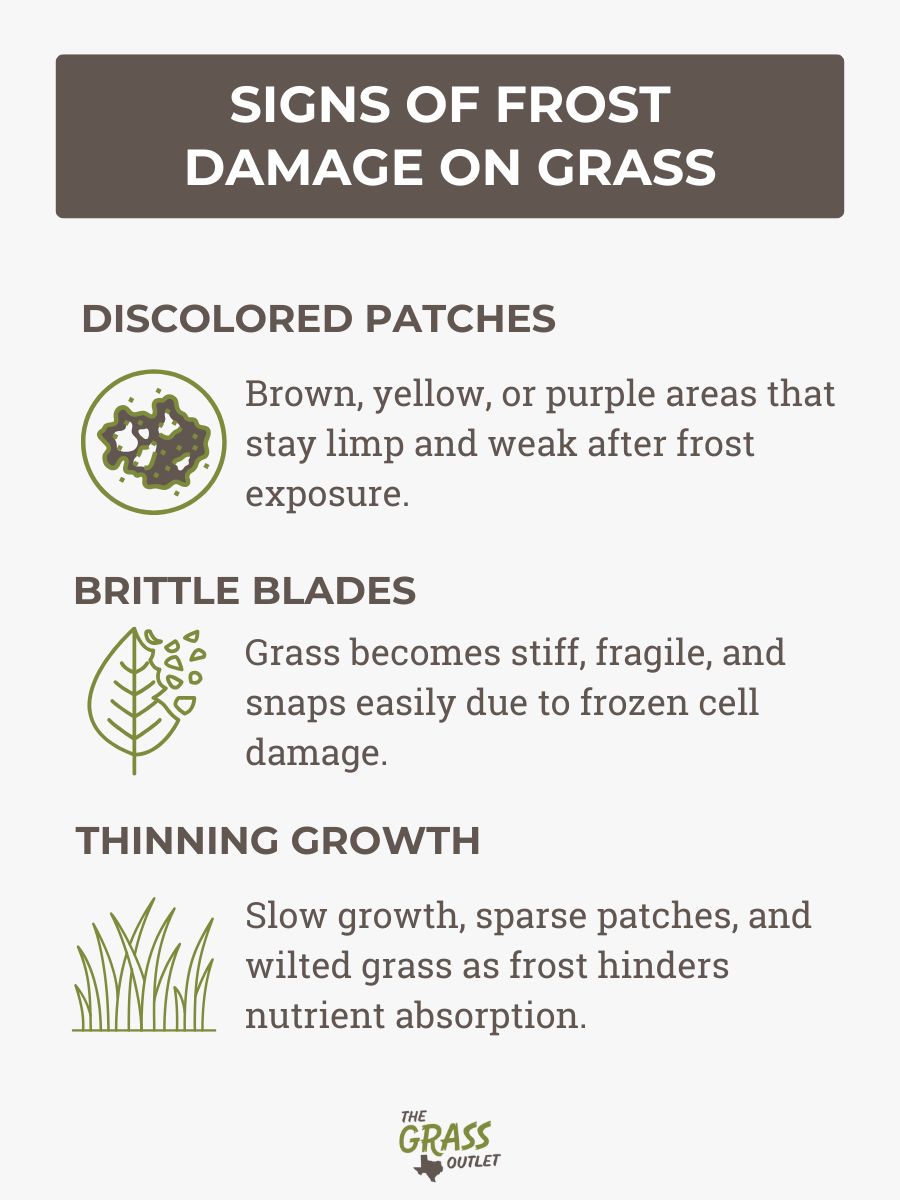
Here are some common indicators of frost damage to keep an eye on:
- Discolored or Brown Patches: During winter, grass often turns brown due to natural dormancy, but frost-damaged grass has specific characteristics. It may appear limp and weak, particularly after foot traffic, as the frozen blades lose structural integrity. Patches of browning or yellow grass in winter that don’t bounce back with sunlight and warmth can indicate more profound frost damage.
- Brittle Grass Blades: Grass exposed to frost becomes stiff and fragile because the water inside its cells freezes and expands, damaging the cellular structure. This makes the blades snap or crumble easily when touched, indicating that the grass has suffered significant stress.
- Thinning or Stunted Growth: Frost affects the grass’s ability to absorb nutrients from the soil, leading to slower growth or thinner patches. The damage can make the grass appear wilted, withered, or sparse as the roots struggle to support healthy development in freezing conditions.
By understanding these signs, you can proactively protect your lawn and promote recovery when the weather warms.
Best Practices for Protecting New Grass from Frost
Although you can’t control the climate or environmental conditions that cause frost, you can take steps to protect your grass from the damage it can cause. Here are some tips to help prepare your lawn and plants for the winter weather:
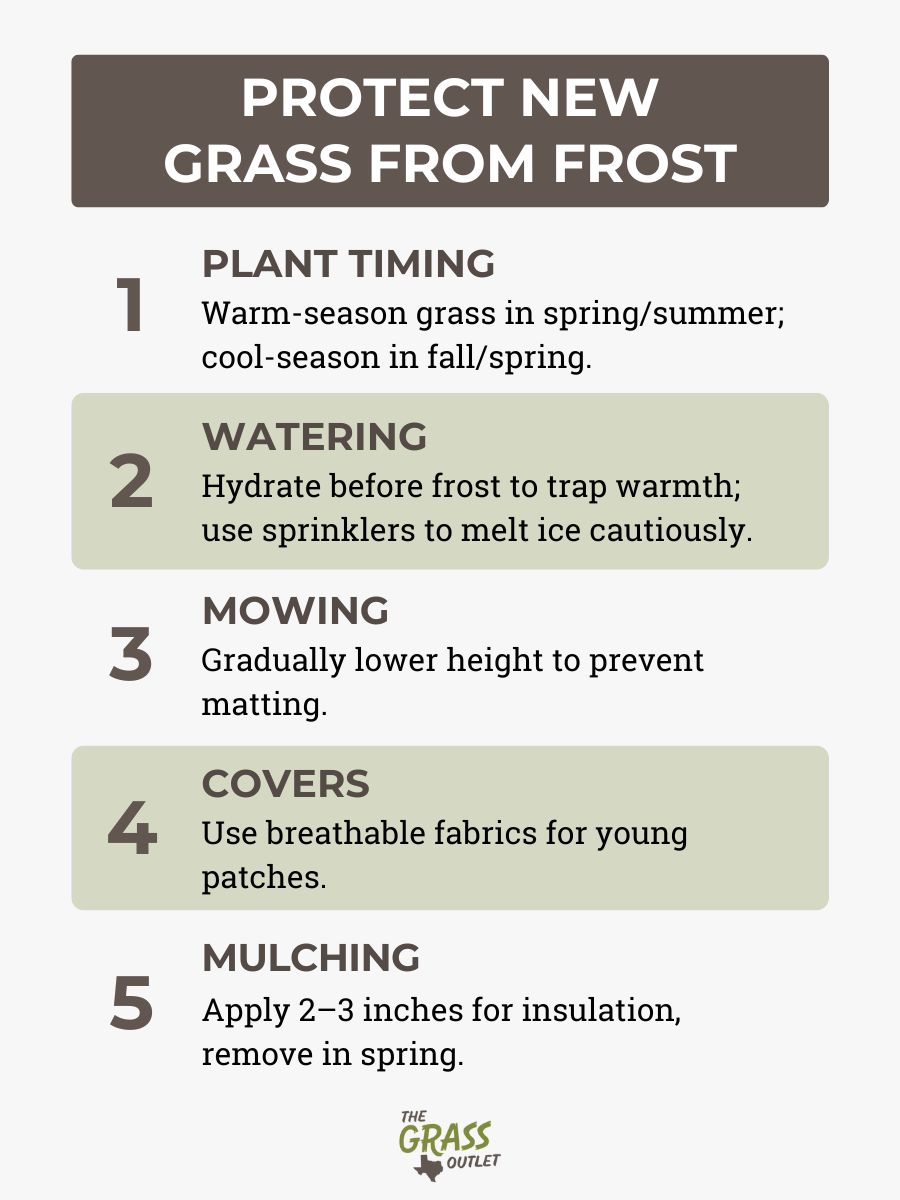
Timing Is Key
Planting new grass too close to the onset of frost can put your lawn at risk. Young grass is especially vulnerable to sudden temperature drops, damaging its cell structure and disrupting its growth. To ensure the best chance for survival, consider the best time to plant grass for different grass types. Warm-season grasses prefer to be planted in spring to early summer, when soil temperatures consistently stay above 65°F (18°C), providing the warmth needed for strong root development. On the other hand, cool-season grasses thrive when planted in early fall or early spring, when soil temperatures range between 50-65°F (10-18°C).
Monitor weather forecasts closely. Frost will likely occur during clear, calm nights following a cold day. Stay informed about upcoming weather conditions and take action if frost is expected. By preparing in advance, you can help protect your new grass and ensure it survives the cold snap, setting the stage for a vibrant and healthy lawn in the seasons ahead.
Watering Tips
It might sound unexpected, but one of the simplest ways to help protect your lawn from light frost damage is by keeping it properly hydrated. Watering your grass deeply the evening before a frost can make a significant difference. As the water slowly evaporates overnight, it generates a small amount of heat around the grass blades, keeping your lawn warmer than its surroundings.
If your lawn freezes overnight and you need to walk on it or let your dog out, using a sprinkler can help melt the ice. If temperatures are too low for this to be effective, it’s best to avoid walking on the frozen grass altogether.
While rainwater is excellent for many tasks around the garden, using tap water for this particular job is ideal, as it tends to be warmer. If you’d prefer not to water manually, consider setting up an irrigation system or using a garden sprinkler. You can program it to run at intervals throughout the night to ensure your lawn gets the hydration it needs before the frost arrives.
Mow Carefully
Longer grass blades are more prone to breaking or becoming matted under ice and snow, which can cause damage during cold weather. To prevent this, it’s crucial to maintain your grass at an optimal height throughout the season.
Gradually reduce the mowing height before the first frost hits, cutting less grass with each pass. The goal is to leave the grass tall enough to allow for proper air circulation while short enough to prevent excess moisture from building up, which could increase the risk of frost damage. Adjusting the mowing height helps ensure your lawn can better withstand the cold.
Use Protective Covers
While covering your lawn with protective materials is generally not practical on a large scale, there are situations where using covers can help safeguard vulnerable areas, especially newly seeded or young grass. For instance, if a particularly harsh frost is expected, covering small patches of grass or new seedlings with breathable fabrics, frost cloth, burlap, or row covers can provide temporary protection.
Frost cloths and lightweight fabric covers can shield delicate grass from freezing temperatures by trapping warmth and preventing direct exposure to the cold. These covers allow moisture and air to pass through, reducing the risk of suffocating the grass while still providing insulation against frost. When using covers, make sure they are securely anchored to the ground with weights or stakes, and don’t touch the grass directly, as this could cause damage during freezing temperatures.
Mulching
Mulching your lawn is an excellent way to protect it from frost and winter damage. The mulch acts as an insulating barrier, shielding your grass from freezing temperatures and creating a stable environment for the root system. It also helps retain moisture and regulate the lawn’s temperature, both essential for your grass’s survival throughout the winter months.
To lay mulch on your lawn, wait until the ground has cooled and the grass has entered dormancy. This is usually after the first few frosts in the fall or early winter, when grass growth has slowed or stopped. Use materials such as straw, wood chips, leaves, or grass clippings to create a layer about 2-3 inches thick. Spread the mulch evenly across the lawn.
Remove the mulch once the weather starts warming up in spring to prevent it from overheating the lawn. Once the grass begins growing during warmer weather, sunlight becomes essential.
Preventing Frost Damage in the Long Term
Taking proactive steps can help your lawn withstand frost and recover more effectively when temperatures drop. By focusing on long-term strategies, you can build a stronger, more resilient lawn capable of enduring cold weather challenges.
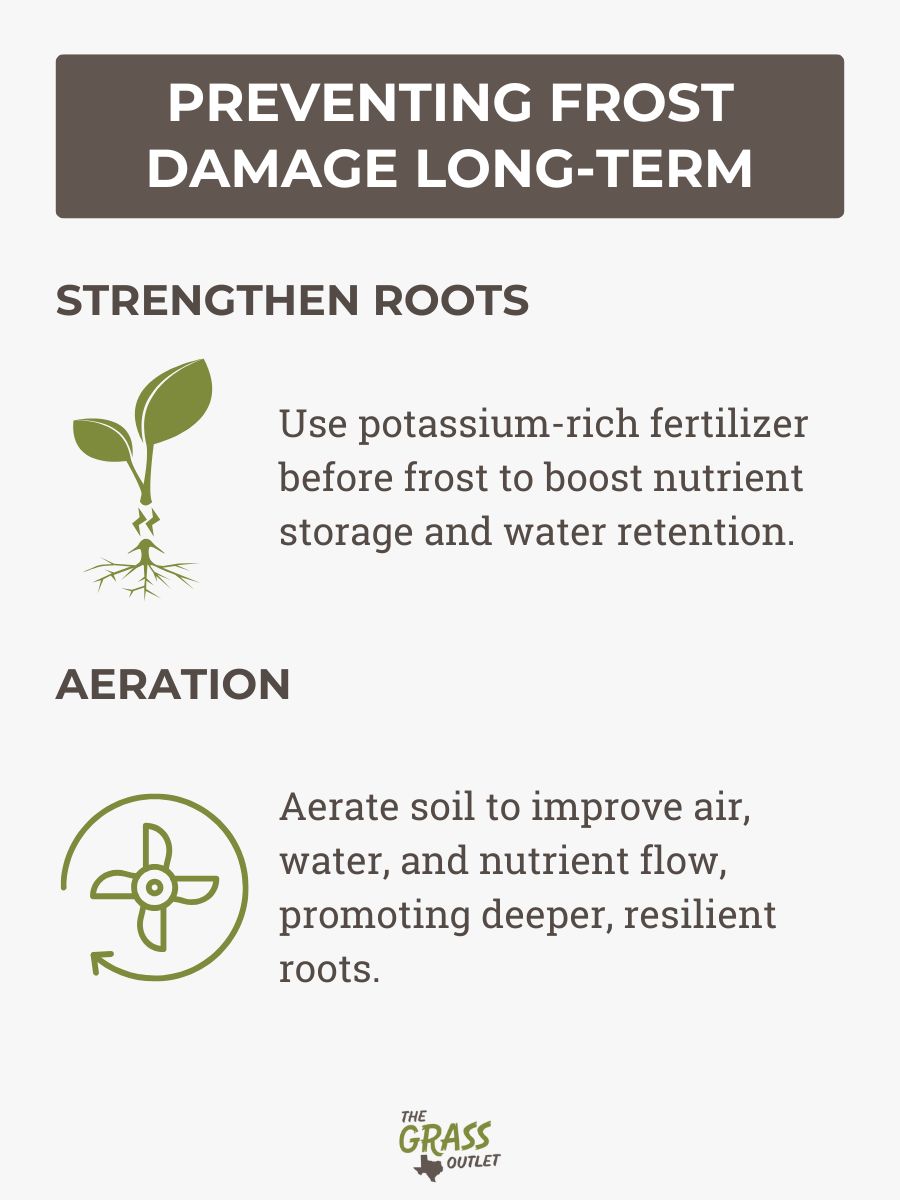
- Strengthening Root Systems with Fertilizers: Applying the right fertilizer, particularly one rich in potassium, before the onset of frost helps fortify your lawn’s root systems. Potassium enhances the grass’s ability to store nutrients and retain water, making it better equipped to survive freezing temperatures. A healthy, well-fed root system acts as a foundation for recovery, even if the blades aboveground are affected by frost.
- Aerating the Lawn to Improve Resilience: Aerating the soil allows better air circulation, water absorption, and nutrient distribution. This process reduces soil compaction, ensuring roots have the space and resources to grow deeper and more robust. Stronger roots anchor the grass more effectively and provide the resilience needed to combat frost damage, keeping the lawn healthier throughout the colder months.
By implementing these strategies, you can create a lawn that’s not only better prepared for winter but also poised to thrive in the following seasons.
What to Do if Frost Damage Occurs
If your lawn has been damaged by frost, there’s still a good chance it can recover with proper care. While it’s always best to take steps to prevent frost damage, there are several actions you can take to help your grass bounce back.
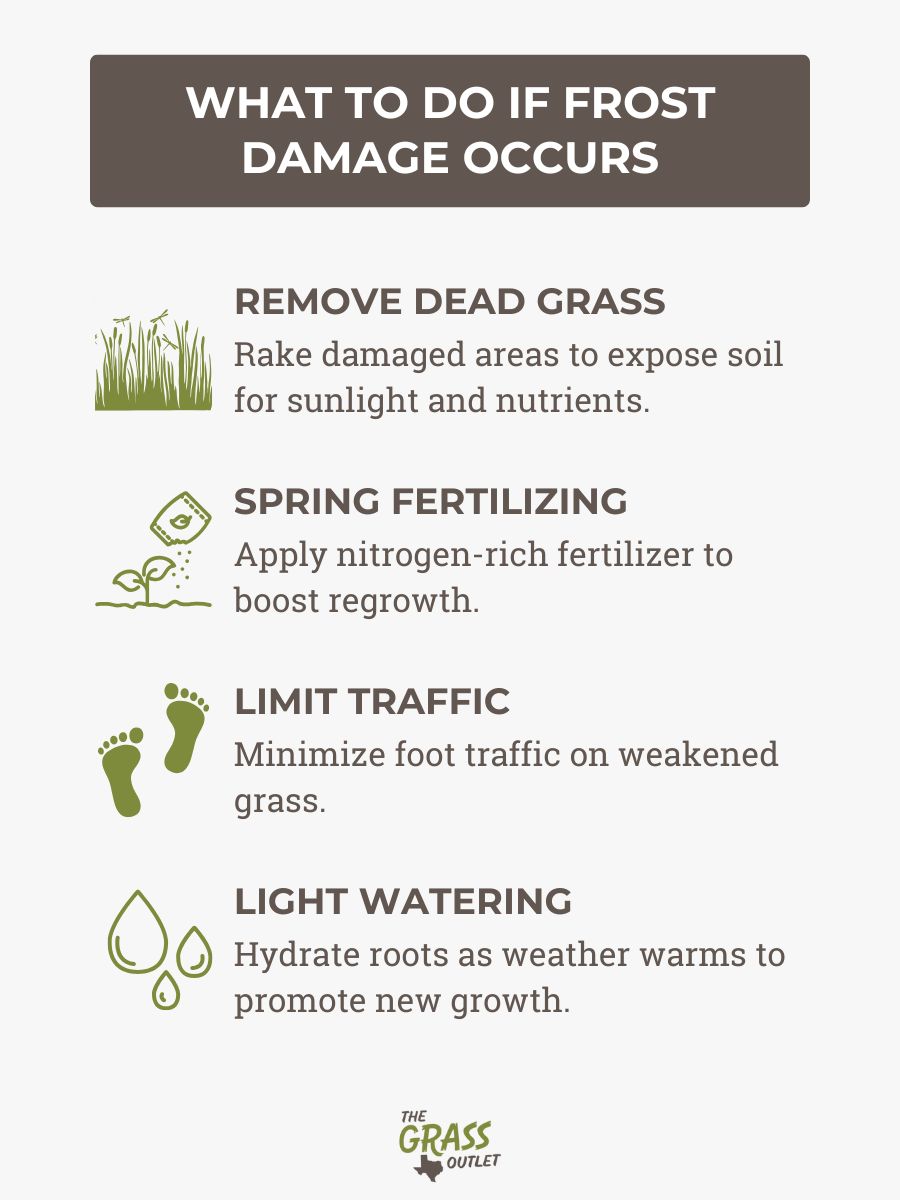
- Remove Severely Damaged Areas: If parts of your lawn are heavily damaged, gently rake away dead grass to allow sunlight and nutrients to reach the soil, promoting new growth.
- Fertilize in Early Spring: Once frost is no longer a concern and your grass is beginning to green up, apply a balanced or nitrogen-rich fertilizer to encourage healthy regrowth and repair damage caused by the cold.
- Avoid Overuse: Limit foot traffic on frost-damaged grass to prevent additional stress on the weakened blades and roots. Allow the grass to heal naturally without added pressure.
- Light Watering: As the weather warms, lightly water your lawn to help hydrate the roots and encourage new shoots to emerge.
With patience and the proper care, even frost-damaged grass can recover and regain its lush, healthy appearance.
Final thoughts
Protecting your lawn from frost requires preparation, care, and timely action.
Understanding the risks frost poses and taking proactive steps can ensure your lawn remains healthy and resilient through the colder months.
If you’re looking for expert guidance or top-quality grass to keep your lawn vibrant year-round, reach out to The Grass Outlet. Our team is here to help you achieve the lush, resilient lawn you’ve always wanted, no matter the season.
Sources:
- How to protect your lawn from frost damage this winter?
- First frosts: How does frost affect your lawn?
